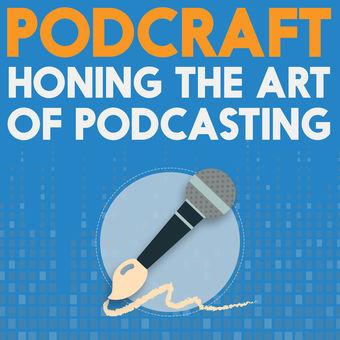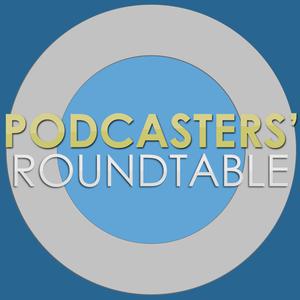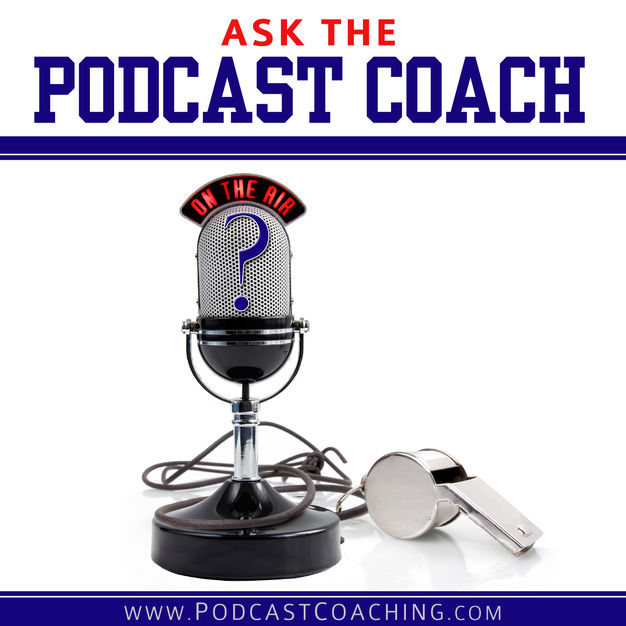
PodCraft | Talking 'How to Podcast' with Bite Sized Nuggets of Podcasting Wisdom
www.PodCraft.net - Colin Gray
This podcast is all about the brilliant world of Podcasting – teaching you how to grow from novice podcaster to confident broadcaster. In this podcast I cover the full range of Podcasting skills, looking at: Podcasting Equipment – what microphones to buy, when to get a mixer, how to set it all up. Podcasting Techniques – recording interviews, recording outside events. Podcast Editing – what software to use, how to create the best audio possible. Podcast Promotion – how to grow your audience, how to market your brand. Podcast Planning – scripting, episode planning, topic generation. Podcast Monetisation – how to make money out of your broadcast without turning off your audience. And more – podcasting environments, events, speaking skills. I'll be bringing on guests from popular podcasts, talking to novices and experts alike, and generally helping you to create the best podcast possible. If you have any suggestions for future episodes, or feedback on the podcast, get in touch on tw
- 10 minutes 43 secondsTry These 6 Compelling & Shareable Content Frameworks
A quickfire episode running through the following content frameworks, with examples and exercises on how to apply them in your own podcast.
Lists: Where you break things down into bite-sized, numbered pieces that are easy to skim and share. Use lists to highlight top picks, tips, or resources your audience will love.
Comparisons: Where you help people decide by putting two options head-to-head. Break down the pros and cons so your audience can make smarter, more confident choices.
Reviews: Where you share your honest opinion about a product, service, or experience. Show your audience what’s great, what’s not, and whether it’s worth their time or money.
Case Studies: Where you tell real-life stories to inspire or teach your audience. Dive into successes, challenges, or unique approaches that they can learn from or relate to.
Costs: Where you break down what things cost and whether they’re worth it. Help your audience understand where to spend, where to save, and what to expect financially.
How-Tos: Where you teach your audience how to do something step by step. Make it simple, clear, and actionable so they can achieve their goals with confidence.
16 January 2025, 10:41 am - 47 minutes 55 secondsHow Much Do Podcasters Make? & What's IN & OUT in Podcasting This Year?
Podcast celebrities aside, how much money can the everyday independent podcaster expect to make?
Well, the answer is “it depends”. But, based on our own experiences of well over a decade in the medium, here are some realistic breakdowns, examples, and goals.
Full article: How Much Money Do Podcasters Make?
Elsewhere, we also talk through a brilliant piece by Lauren Passell and Arielle Nissenblatt of Podcast Marketing Magic: Podcast Marketing and Publishing: What’s in and What’s Out for 2025?
10 January 2025, 7:00 am - 32 minutes 40 secondsWhy So Many New Podcasters Are Embracing Solo Shows (Classic Episode)Colin and Matthew analyse some interesting data from our Podcast Planner tool. 43% of over 1,500 respondents told us they’d rather host a solo show than create content with other people. So why might this be? Perhaps there's a bit of post-pandemic Zoom fatigue in here where people are fed up with feeling like they are "on a call". There are a lot of positive reasons for going solo, too, including the flexibility, simplicity, control, and ownership. Here's the full report if you'd like a look over the data for yourself: https://www.thepodcasthost.com/business-of-podcasting/solo-podcasting/3 January 2025, 8:00 am
- 31 minutes 33 secondsUltimate Podcaster Time-Saving Tips (Classic Episode)
Do you ever find yourself thinking, "I have so much time to work on my podcast, I struggle to even fill it"?
No?
Well, let's see what we can do about that, then. Here are nine great podcasting time-saving tips for you to try out.
- Batch recording
- Use fewer tools
- Do fewer things
- Don't multitask (and, time block)
- Click/MEE editing
- Speeded-up editing
- Use templates
- Utilise dynamic ads
- Automate and outsource wherever possible
27 December 2024, 7:31 am - 45 minutes 18 secondsGetting Booked on Other Shows, Listener Pet Peeves, & How to Get Feedback
Being interviewed on another podcast is a great way to bring value to a wider audience and grow your own as a result. But most podcasters (even those who don't run interview shows) have inboxes choked full of spammy and cynical requests to guest on their show. On this episode, we'll show you how to create a compelling pitch that actually gets seen by its intended recipient. Who knew such things were possible?
On top of that, we discuss podcast listener pet peeves, as well as the various ways you can (effectively) get feedback on your podcast!
Mentioned
19 December 2024, 8:00 am - 55 minutes 53 seconds9 Great Podcast Stats From 2024
We've run a fair few surveys and reports this year, all of which have produced some interesting and actionable data. On this episode, we look at nine headline stats from 2024, and talk through the takeaways and lessons we can glean from them.
- “If It’s Not Got an RSS Feed, It’s Not a Podcast,” say 67% of Podcasters
- Most Podcasters Upload Audio-First Content to YouTube
- Survey Reveals How Listeners Want to Engage With Your Podcast
- Only 8% of Podcasters Enter Awards
- Only 1 in 4 Podcasters Monetise
- The Blue Yeti is Still the Most Popular Mic
- Instagram and Facebook Are the Most Popular Social Platforms for Podcasters
- Data on How Podcasters Measure Success
- Most Listeners Find it Easy to Discover New Podcasts
12 December 2024, 11:06 am - 34 minutes 24 secondsKeep Publishing Over the Holidays - Here's Why...
It's tempting to take a break from podcasting over the holidays, not because you necessarily want to, but because you think your audience will do the same. However, data from the latest Podcast Marketing Trends Report suggests that isn't true, and December is actually one of the top months for combined podcast downloads.
On this episode, we dig into the details and offer some tips for keeping your feed active without doing yourself out of a well-earned rest.
Mentioned
5 December 2024, 9:48 am - 1 hour 7 minutesPodcast Discovery Stats: How Folks Find Pods, & Why They Listen
It's time to delve into the findings of our 2024 Podcast Discoverability Survey. Here, you'll find data on everything from whether or not it's easy to find new podcasts, to how audio quality and ads affect podcast listenership.
We also talk through some other new posts on the site, as well as some published elsewhere (including one that we disagree with quite heavily!).
- The Podcast Discovery Report 2024
- MOVO iVlogger-PRO Review
- Best Podcast Directories
- Full Disclosure: The Power of Unedited Audio (Blubrry)
- Do we need to kill off the word Podcast? (John McDermott)
- Adapt or Get Left Behind: The Future of Podcasting Is Multi-Platform (Max Cutler)
- The Hidden Risks of YouTube and Spotify That The Suck-Up Podcast Bros on LinkedIn Won't Admit (Neal Veglio)
28 November 2024, 11:48 am - 29 minutes 15 secondsHow to Create an Irresistible Value Proposition for Your Podcast (and why it matters!)
In this episode, Colin covers two major topics to help podcasters improve their shows. First, he dives deep into creating a unique value proposition, sometimes called a unique selling proposition (USP) for your podcast, explaining how to make your show stand out and attract more listeners. He breaks down what makes a great USP, using examples from brands like Airbnb and Fjallraven, and shows how to apply these principles to podcasting. The second half focuses on interview preparation, where Colin shares nine actionable tips to conduct better podcast interviews, from proper guest research to creating engaging conversations that benefit both the guest and the audience.
25 November 2024, 9:47 am - 42 minutes 10 secondsPodcast Comments, Feedback, & Engagement. And the Benefits of a Good Media Kit
There are plenty of places online where you can ask for podcast comments and get in on the episode discussion. Here are some of the more popular options.
And, does your podcast need a media kit? Yes, definitely. A podcast media kit is a package of information about your podcast that’s easy to share and consume.
Also Mentioned
15 November 2024, 8:00 am - 47 minutes 40 seconds9 Common Podcasting Mistakes (& How to Avoid Them)
It isn't hard to make a podcast. Making a good podcast, however, is not easy. Here are nine common podcasting mistakes: think of this as a map to the traps that many podcasters tend to fall into, so you can avoid them.
Also Mentioned
8 November 2024, 6:41 am - More Episodes? Get the App
Your feedback is valuable to us. Should you encounter any bugs, glitches, lack of functionality or other problems, please email us on [email protected] or join Moon.FM Telegram Group where you can talk directly to the dev team who are happy to answer any queries.
 Podcast Quick Tips
Podcast Quick Tips
 Podcasters' Roundtable
Podcasters' Roundtable
 Ask the Podcast Coach
Ask the Podcast Coach
 Podcast About Podcasting
Podcast About Podcasting